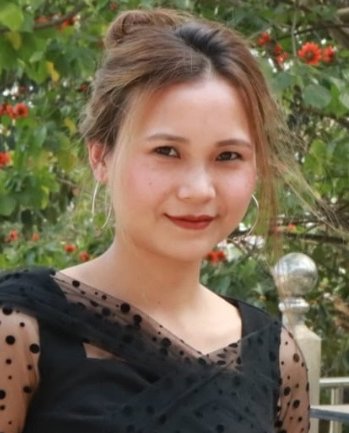
Abstract: This paper attempts to describe the different mistakes committed by a child acquiring his mother tongue and how those mistakes are later corrected through continuous exposure to the language environment. The observation was not made under controlled environment and not studied in a language laboratory. On the other hand, since the child is undergoing the important process of acquiring his mother tongue, the learning environment was not disturbed or controlled in any manner and the child had the liberty to commit mistakes and later learn by imitating the correct usages of adults in the family. Since children learn their first language(s) under different conditions, there is no argument that the findings from this paper will be the same in other children.
Key words: Language, Mizo, mother tongue, first language.
(Abbreviations: L1 – First Language, MT – Mother Tongue)
Introduction:
Language can be regarded as one of the best gifts received from God. It is a fact that we are born without a language, but as human beings, we have the innate ability to learn language. Our exposure to the world of language through continuous listening to others using the system of language for communication creates in us the desire and the need to learn the language to which we are exposed to. An infant can communicate only by making noises and crying which is very much limited for communication. However, the child soon learns that crying and making noise alone can never be enough for communicating with the people around her/him. So, the child begins to imitate the sound that s/he hears by using her/his speech organs and putting into work the marvelous system that she will be using in future for talking to others. Thus the journey of language learning begins.
Let us look at the definition of language given by Edward Sapir: Language is purely humanand non-instinctive method of communicating ideas,emotions and desires by means of a system of voluntarily produced symbols.From this definition, it can be concluded that only human beings are blessed with this means of communication called language. A human child will definitely learn language(s) from her/his parents even without any request or pressure, while any other living beings staying with human beings – maybe as pets – will never learn to speak like human beings. There can be few exceptions of some pet animals imitating the sounds made by human beingswithout understanding the concept or the meaning of the spoken words or phrase.
The environment in which we grow up will affect the learning of any language. If children are exposed to a favourable language learning environment, they can learn 3/4 languages or more without much difficulty. Mizo children, born and brought up in other places – for instance Shillong – can acquire/learn Mizo, Khasi, Hindi, English or other languages spoken around them as they have the advantage of getting exposed to an environment where different languages are spoken.On the other hand, many Mizo children are exposed only to Mizo language which is why they can communicate in that particular language only.
Challenges are a part of the language learning process. However, the challenges faced during learning a language or languages can differ under different circumstances and environment. The challenges faced while learning a first language and the challenges of learning languages other than the first language will be very much different and the challenges can be tougher if the learner is not exposed to a favourable language learning environment. One of the earliest challenges faced by first language learners is the control of the speech organs. A child will try to imitate the sound produced by the people around her/him using her/his speech organs. S/He is sure to face problem in pronouncing some sounds or words, have trouble using words in context, and face problem speaking in a grammatically correct words or sentences.
A child is able to communicate fluently in her/his MT long before s/he starts her/his school. The language thus acquired is also called the first language which is acquired through interaction with other language users. George Yule (2010) talks about the different stages of language development which can be understood as the pre language stage (cooing and babbling), the one-word or holophrastic stage, the two word-stage, telegraphic speech, the acquisition process, developing morphology, developing syntax and developing semantics. During these different stages of acquiring the first language, the child will learn by listening to the languages spoken around her/him and try to imitate the sound which in turn will exercise the speech organs anddevelop the speech organs to suit the demands of the language(s) being learned. The speech organs are so tuned to be used for the MT or the first language that it can have an adverse effect on the learning of languages other than the MT/L1 which is known as ‘MT interference’ or ‘Pull of the MT’. Language learner imitates, commits mistakes after mistakes and learn to correct the mistakes committed by learning from adults or elder siblings who already are proficient in the language.
The memorable mistakes committed by a boy child will be the main focus of this paper and will be described as under:
A. Substitution – Substitution is one of the most common mistakes committed by any language learner. While learning a second language or any languages other than the MT, learners tend to substitute sounds, words, order, etc with sounds and usages which they prefer or which is closest to the target language as used in the MT. However, since the child under observation is learning to speak his MT without little influence of other languages, the substitution is difficult to explain, but, on the other hand, is very noticeable. The substitution of one sound for another is the most prevalent which can be seen from the following instances:
1. Consonant cluster of /tl/ is substituted with /kl/.
Eg – /klan/ instead of /tlan/ (to run)
/kla/ instead of /tla/ (to fall or to drop)
/klu/ instead of /tlu/ (to fall down).
However, it must be noted here that /t/ is not substituted with /k/. So, /ti/ (to do), /tui/ (tasty), /tui/ (water) etc, are pronounced correctly.
2. Consonant cluster of /hr/ is substituted with /s/ which is common in other children too (I noticed this substitution in many other children too – ZTL).
Eg – /siau/ instead of /hriau/ (needle)
/sia/ instead of /hria/ (to know)
/suai/ instead of /hruai/ (to bring along)
3. The sound /nh/ is substituted with /n/ and /mh/ with /m/ not using the voiceless sound of the consonant clusters of /h/+/m/ or /h/+/n/
Eg – /nar/ instead of /hnar/ (nose/to snore)
/nai/ instead of /hnai/ (near)
/niam/ instead of /hniam/ (short/not tall)
/mai/ instead of /hmai/ (face)
/mu/ instead of /hmu/ (to see)
4. The voiced sound /K/ and the voiceless sound /Kh/ substituted with /n/
Eg – /en/ instead of /eK/ (light/to give light)
/san/ instead of /saK/ (tall)
/tan/ instead of /taK/ (to get stuck)
/nal/ instead of /Khal/ (to do something at once)
/niK/ instead of /KhiK/ (to be shaken)
/nak/ instead of /Khak/ (to wait)
5. The /r/ sound is substituted with /w/
Eg – /wim/ instead of /rim/ (odour)
/wei/ instead of /rei/ (to take a long time)
/wi/ instead of /ri/ (sound of something)
/wiK/ instead of /riK/ (a loud sound)
6. In Mizo, there is a special sound /ch/ which is a voiced sound and this sound gets more difficult to be pronounced with the addition of another /h/ sound which resulted in the cluster of consonant sounds of /ch / + /h/. This sound is substituted with /t/.
Eg – /taK/ instead of /chhaK/ (bread)
/tak/ instead of /chak/ (strong)
/tiu/ instead of /chiu/ (to pierce with a needle)
/taw/ instead of /chaw/ (food/rice)
7. Ommission of /l/ sound and substituted with /u/ sound at word end
Eg – /kau/ instead of /kal/ (to go)
/siu/ instead of /sil/ (to wash with water)
/feu/ instead of /fel/ (good mannered)
/bau/ instead of /bal/ (dirty)
/inbuau/ instead of /inbual/ (to take bath)
/meu/ instead of /hmel/ (looks/appearance/face)
/teu/ instead of /tel/ (cooking oil)
/beu/ instead of /bel/ (container)
/muhiu/ instead of /muhil/ (to sleep)
B. Word Order – Mizo follows a complex word order which sometimes could be confusing for early learners and people learning Mizo not as their L1. It is perfect to say Vawt (cold) ka (I) ti (feel) in Mizo. However, this word order could have an influence on other phrases or sentences and the child under observation is seen to have followed this word order to describe other actions which is not correct in the grammar of the language.
For example – The structure of Vawt ka ti is followed as below:
Huai (Brave) ka ti instead of Ka huai (I am brave)
En (Watch) ka ti instead of Ka en (I am watching)
Ngai (To miss someone) ka ti instead of Ka ngai (I miss someone)
Duh (Want) ka ti instead of Ka duh (I want it)
Ei (Eat) ka ti instead of Ka ei (I eat something)
In Mizo, it is correct to say Ka (I) kal (go) duh (Want) which means ‘I want to go’.This word order is followed in many phrases describing desires to do or have something. However, the child under observation committed the following mistakes
Eg – Instead of Ka en duh (I want to see), En ka duh
Instead ofKa lei duh (I want to buy), Lei ka duh
Instead of Ka ak duh (I want to carry a bag), Ak ka duh
It ishowever correct to say Vur (Icecream) ka duh to describe the desire to have/eat an ice-cream. The change in the position of the personal pronoun KA makes it difficult for the child to know when and how to use the correct word order. To describe the desire to have things which are classified as nouns, the noun words come first, followed by the personal pronoun KA. However, to describe the desire to do something using action words/verbs, the personal pronoun KA comes first in the phrase.
To understand the change in position of KA, let us look at the following examples of correct usages in Mizo:
Ka mu (sleep) duh, Ka infiam (play) duh, Ka zai (sing) duh, Ka hmu (to see) duh, etc
Apple ka duh, Pencil ka duh, Car ka duh, Eitur (eatables) ka duh, lhian (friends) ka duh
C. Underextension and Overextension – Underextension can be understood as using a word in a more restrictive manner due to the limited vocabulary of the child or limited knowledge of the possibility of using word(s) in different context. Overextension however suggests the use of words or terms to too many referents due to limited vocabulary or limited knowledge of the language.
1. In Mizo, the word ‘Mama’ is used to refer to a boy child or a young boy. The child under observation, however, uses the word Mama to describe younger or smaller creatures of any living beings. This is due to the limited vocabulary of the child. He will refer to younger living beings as ‘Dinosaur mama’ (young ones of a dinosaur), Mama rul or Rul Mama (Rul is snake), Sava mama (Sava is bird),Zawhte Mama (Zawhte is cat), Ui Mama (Ui is dog).
2. In Mizo, ‘keng’ is used to denote to hold something in the hand. However, if we are to refer to holding human beings – parents holding their children – the word‘pawm’is used which can also mean to embrace, to hold or to hug. So, the child, before knowing the use of ‘pawm’ will say to his father, ‘Apa, min keng rawh’. The correct way to say is ‘Apa, min pawm rawh’ (Dad, please hold me). However, it would have sounded so impressive for the father.
3. As mentioned above, ‘pawm’ is used for holding or embracing. As the child develops, he can differentiate keng and pawm gradually. However, there are other new terms to describe other positions or state of being. To sit on the shoulder is referred to as ‘kokichhuan’ which is a difficult word. It is a word developed by combining two words, that is by compounding of koki (shoulder) and chhuan (to mount up, to let something rest upon something). So, the child, instead of saying ‘Apa, min kokichhuan rawh’ (Dad, make me sit on your shoulder) will say, ‘Apa, i nghawngah min pawm rawh’ (Dad, hold me on your neck).
4. The use of proper noun instead of personal pronoun is very common, especially when referring to oneself. This happened because the child could not make use of personal pronouns due to limited vocabulary. Personal pronouns like Ka, Keimah, Keima, Kan, Keimahni, etc are regularly used in Mizo but the child will normally use Proper noun, mentioning his name and the name of others instead of using these personal pronouns. For example – Hei hi tu kawr nge? (Whose shirt is this) may be answered as Keima (mine) kawr (shirt) or, keimah (me/mine), or Ka kawr (my shirt). However, the child will say, Zokima (referring to himself), Zokima kawr (Zokima’s shirt), Zokima ta (belonging to or owned by Zokima).
Works Cited
- Sapir, E. Language: An Introduction to the Study of Speech. New York. Harcourt, Brace. Reprint: Dover Books on Language. 2004
- Yule, George. The Study of Language. New York. Cambridge University Press. 2010
Cite the original source:
Zothanliana, Dr. R. “Memorable Mistakes: Acquiring a Mother Tongue” Mizo Studies, X, no. 3, Sept. 2021, pp. 451–458.
![]()




